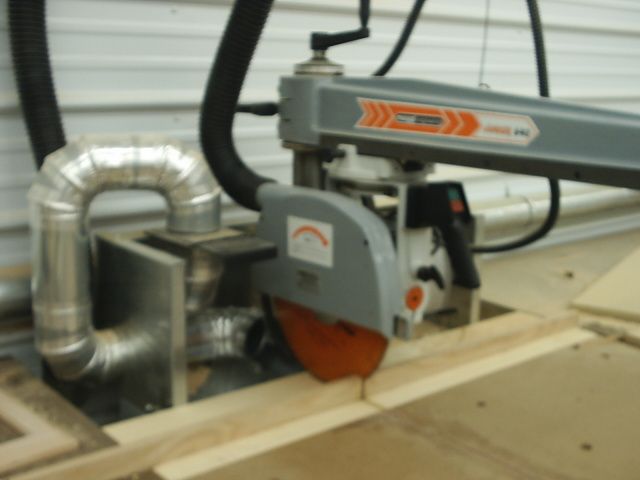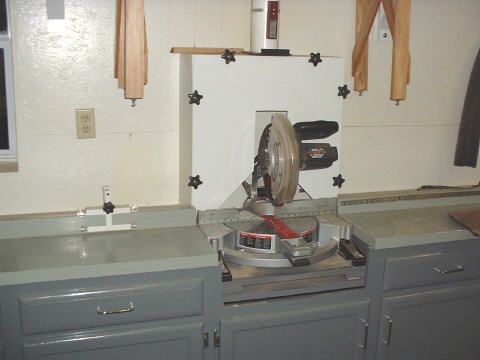Dust Collection and Safety Equipment Forum -- Chop Saw Dust Collection
Ideas for collecting dust at a chopsaw work station. August 29, 2006
Question
Who's got some great ways to collect dust at the chop saw? Right now I'm using what's called a Big Gulp Dust Hood. It's okay, but there is still a lot of dust escaping.
Forum Responses
(Dust Collection and Safety Equipment Forum)
From contributor R:
Make friends with a tin-knocker so he can make you a nice big sheet metal enclosure. While he's at it, have him make one for your hinge machine too! This assumes you've a good dust sucker.
From the original questioner:
What does your shroud look like? Do you have a picture?
From contributor R:
Here's a sketch. You can provide your own dimensions and tin knocker :-)

Click here for full size image
I was just perusing a catalog and saw one you might check out: eagle-america.com. Item # 485-3870. It is a plastic hood that swivels with the saw. If you don't have a tin knocker friend, this might be the ticket.
From the original questioner:
Thanks for the sketch. I have a friend that works in metal. The item from Eagle is interesting. It looks like the best I've seen pre-built so far.
From contributor O:
This is a radial arm, but same theory. It sucks in the jet stream of the saw. It's neat to watch, looks like a tornado, had the same space limits as the above drawing.

Click here for full size image
From the original questioner:
Thanks for the photo. Adding a separate hose for the upper exhaust spout would definitely help. Do you have a separate blast gate for it? I can't quite see all the tubing right behind the saw. It seems to go in a loop. Can you tell me or show me more closely how you did the pipes?
From contributor O:
Here's a little better picture. It does a loop so I could put the intake directly in path of saw dust from blade, and the hose on the blade guard is just for looks. I have even hooked it to a separate collector and have yet to get a spoonful of dust from it. I even built a Plexiglas extension for the blade guard that was almost zero clearance and still little to no help. If I open that blast gate and run the saw with dust collector off, it will pressurize the entire system and expand the bag on the dust collector. Great for beating out the bag, and a good example of the air volume, pressure and dust from a saw blade. I think my setup, along with a down draft add on at a later date, would be best, but the above system works good.

Click here for full size image
From the original questioner:
The picture is great and I can see what you did. On my chop saw, there is tons of dust pouring out of the exhaust port. I might try to do what you did with separate lines, which would let me focus on just trying to catch the dust right behind the blade and not both dust exits with the main duct.
From contributor W:
I believe it was Yankee Workshop that had a chop saw dust collection system that had a 6-4 aluminum reducer set up under the saw like a funnel to collect the dust under the saw.
From contributor T:
Air Handling Systems has a great tip on chop saw dust collection – see airhand.com.
From contributor V:
This is what our shop uses for our chop saw. As you can see, it doesn’t get 100% of the dust, but it gets most of it. It’s not much more than a plywood box with the dust collection pipe connected to the top. The front of the box comes off by removing the star wheels. It has to be taken off when we swing the saw to the right for a 45-degree cut.

Click here for full size image
From contributor B:
I'm currently making hoods for my tools. Do you think that the performance of your hood would be improved if the dust collection tubing was brought in from the bottom? Any other thoughts on how it might be improved?
From contributor V:
On our chop saw, it seemed that the natural flow of the dust as it left the saw was back and up before it settled. So it seemed best to hook the dust collection on the top of the box, as the dust was headed that way as it left the saw. And… our dust collection system is overhead, so that was the easiest way for us. But I can see advantages to hooking on the bottom. On our setup, a certain amount of dust does settle at the back on the bottom. You would eliminate this buildup with a bottom connection.
From contributor B:
Air currents are odd systems - especially in enclosed spaces (like shops!). Most of my tools seem to push or drift dust down, so I assumed it was gravity. You've set me a new task to watch more carefully before I build the hoods.



